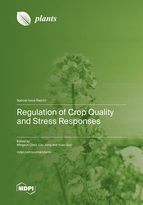Regulation of Crop Quality and Stress Responses
A special issue of Plants (ISSN 2223-7747). This special issue belongs to the section "Plant Genetics, Genomics and Biotechnology".
Deadline for manuscript submissions: closed (20 June 2023) | Viewed by 31240
Special Issue Editors
2. College of Agronomy, Northwest A&F University, Yangling 712100, China
Interests: fatty acids biosynthesis; abiotic stress; seed development
Special Issues, Collections and Topics in MDPI journals
Interests: functional genomics of brassicas; germplasm of rapeseed; genome editing technologies
2. College of Agronomy, Northwest A&F University, Yangling 712100, China
Interests: synergistic improvement of rapeseed quality and abiotic stress resistance
Special Issue Information
Dear Colleagues,
The studies on mechanisms of crop stress physiology and quality formation are an important basis for breeding high-quality and stress-resistant varieties. Changes in physical, chemical, and biological environmental factors in the nature all have impacts on the processes of crop physiology, biochemistry, and growth and development. Moreover, global climate change is leading to a frequent occurrence of extreme climates, which puts forward higher requirements for the adaptability of crops to biotic and abiotic stresses. On the other hand, crop adversity adaptability is closely related to the quality of agricultural products. Therefore, understanding the mechanisms that crops use to respond to environmental changes is of great significance to improve their quality. In view of this basic proposition, this Special Issue will select and publish related research papers (or reviews) on topics including rice, wheat, cotton, barley, rapeseed, soya bean, corn, and vegetables. The contents are very diverse, reflecting the active and meaningful explorations carried out by scholars at home and abroad in order to achieve the goal of high-quality and stress-resistant breeding.
Prof. Dr. Mingxun Chen
Prof. Dr. Lixi Jiang
Dr. Yuan Guo
Guest Editors
Manuscript Submission Information
Manuscripts should be submitted online at www.mdpi.com by registering and logging in to this website. Once you are registered, click here to go to the submission form. Manuscripts can be submitted until the deadline. All submissions that pass pre-check are peer-reviewed. Accepted papers will be published continuously in the journal (as soon as accepted) and will be listed together on the special issue website. Research articles, review articles as well as short communications are invited. For planned papers, a title and short abstract (about 100 words) can be sent to the Editorial Office for announcement on this website.
Submitted manuscripts should not have been published previously, nor be under consideration for publication elsewhere (except conference proceedings papers). All manuscripts are thoroughly refereed through a single-blind peer-review process. A guide for authors and other relevant information for submission of manuscripts is available on the Instructions for Authors page. Plants is an international peer-reviewed open access semimonthly journal published by MDPI.
Please visit the Instructions for Authors page before submitting a manuscript. The Article Processing Charge (APC) for publication in this open access journal is 2700 CHF (Swiss Francs). Submitted papers should be well formatted and use good English. Authors may use MDPI's English editing service prior to publication or during author revisions.
Keywords
- crop quality
- crop physiology
- crop breeding
- crop improvement
- adversity stress
- stress adaptation
- stress tolerance
- resistance mechanism
- fatty acids
- anthocyanins
- melatonin
- plant biotechnology
- molecular biology
- gene expression









